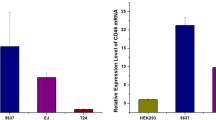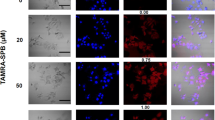Abstract
Adenoviral vectors are widely used for cancer therapy and show a tumor-suppressing effect. However, bladder cancers are found to be resistant against infection of Ad5-derived adenoviral vector, limiting the application of the existing strategy of gene therapy. Therefore, efforts to develop novel types of adenoviral vector aimed for improving the viral infection and enhancing expression level of tumor-inhibiting transgene is urgently required. We constructed a 5/35 fiber-modified E1A-deleted adenoviral vector armed with TRAIL gene. Its ability to express this gene for inhibition of bladder cancer cell growth was investigated in our work. The results showed that this modification in fiber region facilitates adenoviral infection to bladder cancer, perhaps due to high expression of CD46 on target cell surface. Subsequently, we found an enhanced expression level of TRAIL mediated by 5/35 fiber-modified adenoviral vectors in bladder cancer cells, leading to an increased tumor-inhibiting capability of 5/35 adenoviral vector against bladder cancer cells. Consistently, growth of xenograft tumors in mice was also effectively inhibited by 5/35 fiber-modified vector-mediated gene therapy strategy. The 5/35 fiber-modified adenoviral vector-based gene transfer shows an improved efficacy against bladder cancers. The application of this novel gene therapy vector may benefit the patients in clinical bladder cancer treatment.






Similar content being viewed by others
References
Jacobs BL, Lee CT, Montie JE (2010) Bladder cancer in 2010: how far have we come? CA Cancer J Clin 60:244–272
Voutsinas GE, Stravopodis DJ (2009) Molecular targeting and gene delivery in bladder cancer therapy. J BUON 14:S69–S78
Pagliaro LC, Keyhani A, Williams D, Woods D, Liu B, Perrotte P et al (2003) Repeated intravesical instillations of an adenoviral vector in patients with locally advanced bladder cancer: a phase I study of p53 gene therapy. J Clin Oncol 21:2247–2253
Kuball J, Wen SF, Leissner J, Atkins D, Meinhardt P, Quijano E et al (2002) Successful adenovirus-mediated wild-type p53 gene transfer in patients with bladder cancer by intravesical vector instillation. J Clin Oncol 20:957–965
Malmström PU, Loskog AS, Lindqvist CA, Mangsbo SM, Fransson M, Wanders A et al (2010) AdCD40L immunogene therapy for bladder carcinoma–the first phase I/IIa trial. Clin Cancer Res 16:3279–3287
Vardouli L, Lindqvist C, Vlahou K, Loskog AS, Eliopoulos AG (2009) Adenovirus delivery of human CD40 ligand gene confers direct therapeutic effects on carcinomas. Cancer Gene Ther 16:848–860
Bergelson JM, Cunningham JA, Droguett G, Kurt-Jones EA, Krithivas A, Hong JS et al (1997) Isolation of a common receptor for Coxsackie B viruses and adenoviruses 2 and 5. Science 275:1320–1323
Li Y, Pong RC, Bergelson JM, Hall MC, Sagalowsky AI, Tseng CP et al (1999) Loss of adenoviral receptor expression in human bladder cancer cells: a potential impact on the efficacy of gene therapy. Cancer Res 59:325–330
Sachs MD, Rauen KA, Ramamurthy M, Dodson JL, De Marzo AM, Putzi MJ et al (2002) Integrin alpha(v) and coxsackie adenovirus receptor expression in clinical bladder cancer. Urology 60:531–536
Maitland N, Chambers K, Georgopoulos L, Simpson-Holley M, Leadley R, Evans H et al (2010) Clinical adenoviral gene therapy for prostate cancer. Hum Gene Ther 21:807–813
Siefker-Radtke A (2010) Bladder cancer: can we move beyond chemotherapy? Curr Oncol Rep 12:278–283
Gaggar A, Shayakhmetov DM, Lieber A (2003) CD46 is a cellular receptor for group B adenoviruses. Nat Med 9:1408–1412
Ganesh S, Gonzalez Edick M, Idamakanti N et al (2007) Relaxin-expressing, fiber chimeric oncolytic adenovirus prolongs survival of tumor-bearing mice. Cancer Res 67:4399–4407
Yu L, Takenobu H, Shimozato O et al (2005) Increased infectivity of adenovirus type 5 bearing type 11 or type 35 fibers to human esophageal and oral carcinoma cells. Oncol Rep 14:831–835
Hoffmann D, Meyer B, Wildner O (2007) Improved glioblastoma treatment with Ad5/35 fiber chimeric conditionally replicating adenoviruses. J Gene Med 9:764–778
Hoffmann D, Heim A, Nettelbeck DM et al (2007) Evaluation of twenty human adenoviral types and one infectivity-enhanced adenovirus for the therapy of soft tissue sarcoma. Hum Gene Ther 18:51–62
Lindqvist C, Sandin LC, Fransson M, Loskog A (2009) Local AdCD40L gene therapy is effective for disseminated murine experimental cancer by breaking T-cell tolerance and inducing tumor cell growth inhibition. J Immunother 32:785–792
He XD, Wang ZP, Wei HY, Zhou Q, Wang DG, Tian JQ et al (2009) Construction of urothelium-specific recombinant adenovirus and its inhibition in bladder cancer cell. Urol Int 82:209–213
Wu CL, Shieh GS, Chang CC, Yo YT, Su CH, Chang MY et al (2008) Tumor-selective replication of an oncolytic adenovirus carrying oct-3/4 response elements in murine metastatic bladder cancer models. Clin Cancer Res 14:1228–1238
Terao S, Shirakawa T, Kubo S, Bishunu A, Lee SJ, Goda K et al (2007) Midkine promoter-based conditionally replicative adenovirus for targeting midkine-expressing human bladder cancer model. Urology 70:1009–1013
Gomella LG, Mastrangelo MJ, McCue PA, Maguire HC Jr, Mulholland SG, Lattime EC (2001) Phase I study of intravesical vaccinia virus as a vector for gene therapy of bladder cancer. J Urol 166:1291–1295
Rein DT, Breidenbach M, Kirby TO, Han T, Siegal GP, Bauerschmitz GJ et al (2005) A fiber-modified, secretory leukoprotease inhibitor promoter-based conditionally replicating adenovirus for treatment of ovarian cancer. Clin Cancer Res 11:1327–1335
Lu ZZ, Ni F, Hu ZB, Wang L, Wang H, Zhang QW et al (2006) Efficient gene transfer into hematopoietic cells by a retargeting adenoviral vector system with a chimeric fiber of adenovirus serotype 5 and 11p. Exp Hematol 34:1171–1182
He X, Liu J, Yang C, Su C, Zhou C, Zhang Q, et al (2011) 5/35 Fiber-modified conditionally replicative adenovirus armed with p53 shows increased tumor-suppressing capacity to breast cancer cells. Hum Gene Ther 22:283–292
Toyoda E, Doi R, Kami K, Mori T, Ito D, Koizumi M et al (2008) Adenovirus vectors with chimeric type 5 and 35 fiber proteins exhibit enhanced transfection of human pancreatic cancer cells. Int J Oncol 33:1141–1147
Yu L, Shimozato O, Li Q, Kawamura K, Ma G, Namba M et al (2007) Adenovirus type 5 substituted with type 11 or 35 fiber structure increases its infectivity to human cells enabling dual gene transfer in CD46-dependent and -independent manners. Anticancer Res 27:2311–2316
Ma L, Liu J, Shen J, Liu L, Wu J, Li W et al (2010) Expression of miR-122 mediated by adenoviral vector induces apoptosis and cell cycle arrest of cancer cells. Cancer Biol Ther 9:554–561
Conflict of interest
None declared.
Author information
Authors and Affiliations
Corresponding author
Additional information
Youguang Zhao and Ying Li contributed equally to this work.
Rights and permissions
About this article
Cite this article
Zhao, Y., Li, Y., Wang, Q. et al. Increased antitumor capability of fiber-modified adenoviral vector armed with TRAIL against bladder cancers. Mol Cell Biochem 353, 93–99 (2011). https://doi.org/10.1007/s11010-011-0778-5
Received:
Accepted:
Published:
Issue Date:
DOI: https://doi.org/10.1007/s11010-011-0778-5




